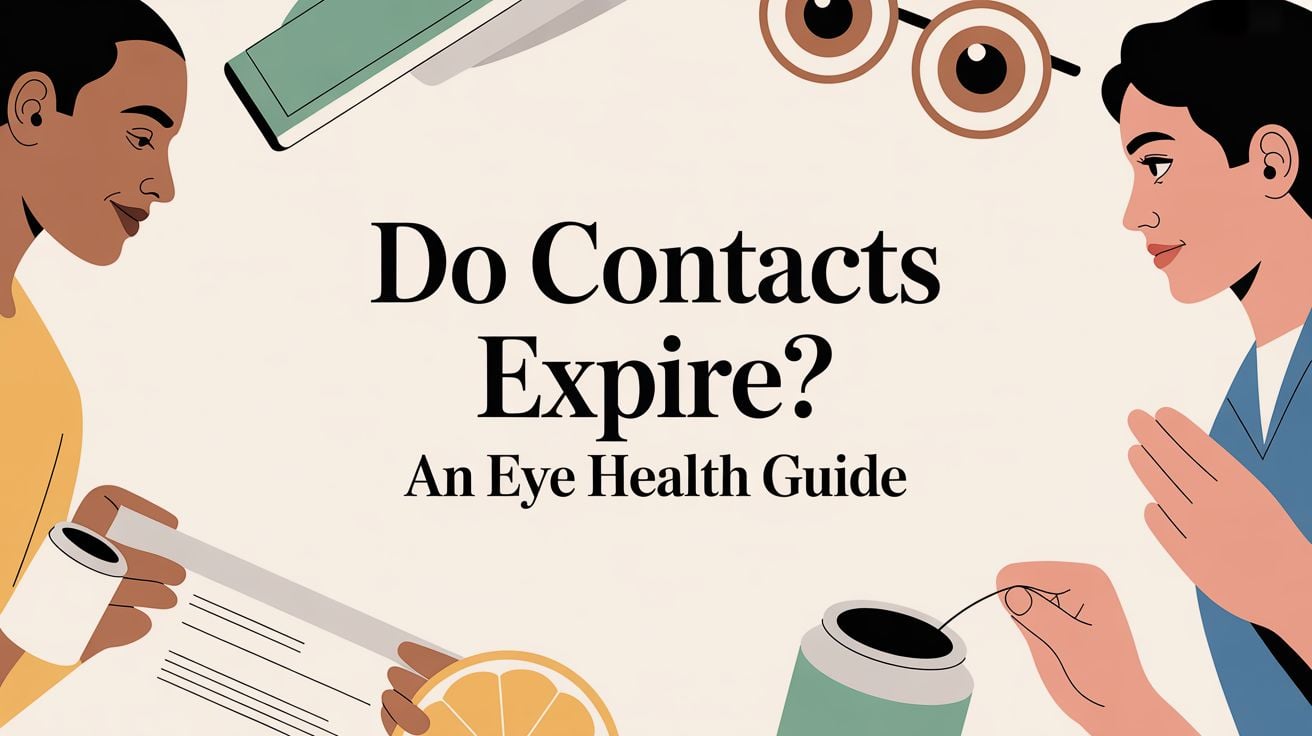Whether you're navigating North Avenue with your GPS or working from your home office in Glendale Heights, you're likely spending hours staring at a screen. It's just part of modern life. But have you noticed that nagging eye fatigue, dryness, or fuzzy vision that just won't go away? It’s a common issue for many of us, from students at Glendale Heights' Glenbard West High School to professionals all over the Chicagoland area.
It’s easy to brush it off as just being tired, but it could be something more specific: Computer Vision Syndrome (CVS). This is a very real condition affecting countless people who rely on computers, tablets, and smartphones every day. At iDoctor in Glendale Heights, our goal is to help you understand the symptoms and find lasting relief.
Are Your Screens Causing More Than Tired Eyes?

Simply put, Computer Vision Syndrome—often called digital eye strain—is a collection of eye and vision problems that stem directly from prolonged screen time. It's an incredibly common issue for so many in our community, from students doing homework to professionals working remotely.
This guide is designed to walk you through the specific computer vision syndrome symptoms, helping you decode what your eyes are trying to tell you. More importantly, we'll help you distinguish between temporary irritation and signals that it’s time for a professional eye exam with an expert eye doctor in Glendale Heights.
Here at iDoctor, we're dedicated to helping our Glendale Heights neighbors enjoy clear, comfortable vision. Learning to recognize these symptoms is the crucial first step toward finding relief that actually lasts.
So, What Exactly Is Digital Eye Strain?

Think about what happens to your muscles during a long, strenuous workout. They get tired, right? That’s a great way to understand what your eyes go through when you stare at a screen for hours. This condition is officially called Computer Vision Syndrome (CVS), but you probably know it as digital eye strain.
CVS isn't one specific problem but rather a collection of eye and vision-related issues that all stem from prolonged use of digital devices. It happens because our eyes have to work much harder to see what’s on a screen compared to, say, a printed book.
The letters and images on a screen are made of tiny dots called pixels, which have less-defined edges and contrast than ink on paper. This lack of crispness forces the focusing muscles in your eyes to constantly readjust to keep things clear. It's like doing thousands of tiny, repetitive push-ups with your eyes, all day long.
This constant effort is what leads to that familiar feeling of fatigue and discomfort. And it's incredibly common—recent studies suggest that Computer Vision Syndrome impacts a staggering 69% of people around the globe, making it a major health issue in our screen-centric lives.
While the discomfort from CVS is often temporary, ignoring the symptoms can allow them to become more persistent, affecting your work and daily comfort. The first and most important step is simply learning to recognize the computer vision syndrome symptoms when they appear.
This visual workload is the core of the problem. For a deeper dive into the mechanics of the condition, feel free to check out our detailed guide on understanding computer vision syndrome.
The 7 Tell-Tale Signs of Computer Vision Syndrome
If you've ever ended a long workday feeling like your eyes have run a marathon, you're not alone. That distinct feeling of discomfort is the hallmark of Computer Vision Syndrome (CVS), sometimes called digital eye strain. These symptoms are your body's way of telling you that your screen time is taking a toll.
Most people notice the effects in two main areas: issues directly impacting their eyes (ocular symptoms) and other physical discomforts like headaches or neck pain (non-ocular symptoms). Let's start by breaking down the most common signs you'll notice in your eyes.
How CVS Directly Affects Your Eyes
The first red flags for CVS almost always show up in your eyes. These issues can start as a minor annoyance but can quickly escalate, making it hard to focus and get through your day.
The number one complaint is eye strain, which doctors call asthenopia. It’s that familiar, nagging ache behind your eyes. It can also feel like a heaviness or fatigue, as though your eye muscles are just plain worn out from staring intently at a fixed point for hours.
Then there's the classic dry eye sensation. When we're locked into a screen, we tend to forget to blink. In fact, our blink rate can plummet by up to 50%. Blinking is what spreads a fresh layer of tears over your eyes, so when you do it less, your eyes become dry, gritty, and irritated. You might even notice a burning feeling that makes you want to squeeze your eyes shut.
You might also find your vision gets a little fuzzy after a while, or that your eyes look red and feel generally bothered. Research consistently shows that blurred vision and eye strain are the most disruptive symptoms for office workers and students, seriously impacting both their comfort and productivity.
This diagram breaks down how screen use leads directly to these frustrating problems.

As you can see, factors like poor lighting, screen glare, and just the sheer amount of time we spend staring at pixels all conspire to cause these symptoms.
Checklist for Eye-Related CVS Symptoms
Use this quick checklist to see if what you're feeling lines up with the common ocular signs of Computer Vision Syndrome.
| Symptom | How It Typically Feels |
|---|---|
| Eye Strain (Asthenopia) | A deep, dull ache in or around the eyes; a feeling of heaviness or fatigue. |
| Dry Eyes | A gritty or scratchy feeling, as if there's sand in your eyes. Often includes burning or stinging. |
| Blurred Vision | Your focus becomes fuzzy, making it hard to read text clearly on the screen or see objects in the distance. |
| Double Vision | Seeing two overlapping images of a single object. |
| Eye Redness & Irritation | Your eyes look bloodshot and may feel itchy or generally uncomfortable. |
| Increased Light Sensitivity | Finding normal indoor lighting or your screen's brightness uncomfortably harsh. |
| Watery Eyes (Tearing) | This might seem counterintuitive, but sometimes very dry eyes overcompensate by producing a flood of low-quality tears. |
These symptoms can feel much worse when you’re also dealing with screen glare. Understanding the benefits of anti-glare glasses is a great starting point, as they are one of the most practical tools for fighting back against this specific problem.
If any of this sounds familiar, don't just brush it off. Recognizing these signs is the crucial first step toward making small changes that can bring you significant relief.
How Digital Strain Affects Your Head and Body

That nagging ache in your neck or the tension building in your shoulders after a long day of work? It might not be random. The strain from our screens often doesn't stay confined to our eyes, sending ripple effects of discomfort through the head and body. Recognizing that these physical pains are linked to your screen time is the first step, as they are key computer vision syndrome symptoms.
One of the most common complaints I hear from patients is about headaches. These aren't your typical headaches; they're directly sparked by the relentless focusing your eye muscles have to do. Think of it as a workout for your eyes that never ends, which can lead to a dull, throbbing pain right behind the eyes or a classic tension headache wrapping around your forehead.
When your eyes are overworked, the strain can easily trigger related pain in your head. It’s your body’s way of signaling that your visual system is overloaded and needs a break.
From Your Neck to Your Back
Poor posture is the other major culprit here. It’s almost a reflex to hunch over a laptop or crane our necks to get a better view of a monitor that isn't set up correctly. This seemingly small habit puts a surprising amount of stress on your entire upper body.
Before you know it, this constant strain can lead to:
- Neck Pain: A stiff, sore neck is the hallmark sign of looking down at a screen for hours on end.
- Shoulder Aches: That tension has to go somewhere, and it often builds up right in your shoulders, causing stiffness and deep-seated aches.
- Back Pain: Slouching in a chair, even a good one, for an entire workday is a surefire way to develop nagging lower and upper back pain.
The good news is that simple ergonomic tweaks to your desk setup can make a world of difference. Combining that with gentle movements is even better. For instance, our guide on eye exercises for eye strain includes techniques that not only help your eyes but can also release some of that related muscle tension in your neck and shoulders.
When to See Your Local Glendale Heights Eye Doctor
Making adjustments to your workspace and taking regular breaks are fantastic first steps. But what happens when the eye strain, headaches, and blurriness just don't go away?
If those simple fixes aren't cutting it, your persistent discomfort is a clear signal that it's time to see a professional. Think of it as your body's check-engine light—it might be pointing to an underlying issue that needs an expert eye.
So, when is it time to make that call? You should absolutely schedule an appointment if you’re experiencing:
- Chronic headaches that linger long after you’ve shut down your computer.
- Vision that stays blurry even when you're no longer looking at a screen.
- Dry eye that has become severe or painful enough to disrupt your day.
These aren't just minor annoyances; they could be signs of an uncorrected vision problem like nearsightedness or astigmatism. Staring at a screen for hours on end simply magnifies these existing conditions, making the symptoms feel much worse. It's a massive issue, too. Global studies show computer vision syndrome affects around 66% of people, with some areas seeing rates as high as 97% due to intense screen use. You can read the full research about these global findings to see just how widespread this has become.
Don't simply tolerate ongoing discomfort. Proactive care is the best way to protect your long-term vision and find lasting relief from digital eye strain.
At iDoctor in Glendale Heights, our detailed eye exams go beyond a standard vision test. We use high-resolution imaging to get a complete picture of your eye health, which helps us find the exact source of your strain and develop a plan that’s tailored just for you. To learn more about the importance of routine check-ups, check out our guide on how often you should get an eye exam.
Finding Relief from Digital Eye Strain in Glendale Heights
Here in our vibrant Glendale Heights community, screens are simply a part of daily life. At iDoctor, we see ourselves as your local partners, dedicated to helping you navigate this digital world with clear, comfortable vision. We focus on real solutions for your screen-heavy lifestyle, whether that means fitting you with advanced contact lenses in Glendale Heights or finding the perfect pair of Tom Ford or Ray-Ban eyeglasses with blue light filtering lenses.
Our 30-minute detailed eye exams are the cornerstone of our approach, giving us a deep understanding of your specific visual needs. We’re here for everyone, from students at our local schools to professionals working up and down Army Trail Road. Our commitment is to provide our community with the highest standard of care and, most importantly, lasting relief from the nagging symptoms of computer vision syndrome.
Living with constant eye strain isn't something you have to accept. As the best optometrist in Glendale Heights, our priority is to find personalized, effective treatments that restore your comfort and protect your vision for years to come.
Finding the right approach is what truly makes a difference for long-term comfort. For a deeper look at all the ways we can help, take a look at our guide on effective digital eye strain treatment.
FAQ: Your Questions About CVS Answered
We get a lot of questions about digital eye strain from our patients here in Glendale Heights. Let's tackle some of the most common ones.
Can computer glasses help if I don't have a prescription?
Yes, they absolutely can. Even if you have perfect 20/20 vision, computer glasses can provide significant relief. These lenses can have specialized coatings that reduce glare and filter harsh blue light from screens, which are two of the biggest causes of eye strain. We offer a wide range of non-prescription designer eyeglasses in Glendale Heights that can be fitted with these helpful lenses.
Where can I find Gucci glasses near me?
You're in the right place. iDoctor is proud to be a premier source for luxury eyewear in the Glendale Heights area. We carry a curated selection of designer frames, including sought-after brands like Gucci, Cartier, Tom Ford, and Prada. We can help you find the perfect style and fit it with lenses designed to combat your specific computer vision syndrome symptoms.
How often should I see an eye doctor for eye strain?
If you spend a lot of time on screens and are experiencing persistent symptoms, an annual eye exam is highly recommended. At iDoctor, our detailed eye exams in Glendale Heights allow us to track your eye health over time, catch any changes early, and make sure your current solution is still working effectively. Regular check-ups are key to managing CVS and protecting your vision.
Ready to put digital eye strain behind you? At iDoctor, we blend advanced diagnostics with luxury eyewear, so you never have to compromise. Book your appointment and see what makes us the premier choice for vision care in Glendale Heights.





